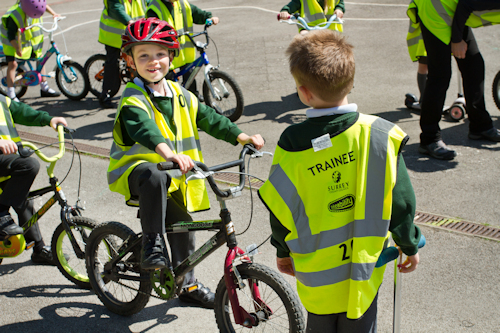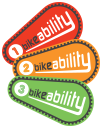Bikeability Course Descriptions
What is 'Pedals'?
Pedals is a practical road safety awareness course for pupils aged 5-7 in Years 1 or 2 at school. This is the age group for whom the road safety learning concept of 'stop look listen' is generally considered appropriate.
Pupils can participate on their bikes, even if they have tricycles, stabilizers, on their scooters, or on foot. The course lasts one hour. The aim is that by the end of the course trainees will be able to:
- Achieve some of the simpler Level 1 outcomes – look behind, set the pedal, start, pedal and stop.
- Explain how wearing a tabard and helmet can improve their safety.
- Stop, look and listen before crossing the road in a simulated traffic environment.
All trainees receive a certificate of participation.

What is Bikeability Level 1?
Bikeability Level 1 is part of the National Standard for cycle training. Watch the Department of Transport video about Level 1.
It teaches basic control and balance skills in a traffic-free environment - generally the school playground. It is suitable for those who have just learned to ride and no longer use stabilisers. The course lasts for 3 hours.
Trainees learn:
- Checking your bike and understanding the need of safety equipment and clothing
- Getting on and off a bike without help
- Start cycling, pedalling and stopping without help
- Ride along without help for roughly one minute or more
- Make the bike go where they want
- Using gears if you have them
- Stop quickly with control
- Manoeuvre safely to avoid objects
- Look all around, including behind, without loss of control
- Control the bike with one hand
All trainees receive a certificate showing their achievement against each individual outcome, enabling their parent or carer to see where they need most help to continue improving their riding.
What is Bikeability Level 2?
Bikeability Level 2 is part of the National Standard for cycle training. Watch the Department of Transport video about Level 2.
On this course, trainees share the road with traffic. The session will begin off road where the Instructors can assess the trainees' current level of cycling skills. The training will then progress on to the road and take place within a risk-assessed training area. Depending on what's available around the school, the training area will include very quiet roads and those that carry more frequent traffic (without being main roads). In this way, Instructors can use their judgement to progress trainees according to their ability. The course is usually 7.5 hours spread over 5 days. Level 2 outcomes are:
- Before going on the road, show that you have the “Level 1” skills of control and balance, so your Instructors know that you are able to go on to the road. Also, that you can check that your bike is safe, for example that the brakes work.
- Start from the kerb, or from the outside of parked vehicles, after you have judged it is safe to start. Set your pedals, look for traffic and for people crossing.
- Stop by slowing down, looking behind for traffic that is following you and pulling over to a safe place on the left. If traffic is following you, signal to let them know you are stopping.
- Look out for hazards. This might be cars approaching from different directions or pulling out .It might be roadworks or a pothole in the road. It might be people who step off the pavement without seeing you.
- Look then make clear hand signals when cars and people are around, so they know what you want to do.
- Take the correct position on the road, clear of the gutter, staying in view of other road users and reducing the chance of a vehicle squeezing past you.
- Pass parked vehicles, looking behind and then, if it is safe, moving out smoothly. Be far enough out that you won’t be hit if someone opens their car door. But also look out for vehicles coming towards you; you may need to move back in. Check for people in the vehicles and recognise signs of a vehicle that could pull out.
- Pass side roads looking out for vehicles turning in and out and understand the correct priority.
- Turn left into a side road. Look behind, signal to other road users and look ahead to see what is in the side road. Look out for people crossing the road, and have another look behind before turning.
- Make a U-turn. Look behind and ahead to make sure there is nothing coming. Cover your brakes when turning and finish in the correct riding position.
- Turn left out of a side road. Look behind, signal to other road users and take the correct position. Understand that traffic on the ‘major’ road goes first, so if there’s any coming, you stop to let it pass. Make the turn when there is a safe space in the traffic. You also look for people crossing the road.
- Turn right out of a side road. Look behind, signal to other road users and move out to the correct position. Understand that traffic on the ‘major’ road goes first, so if there’s any coming, you stop to let it pass. Make the turn when there is a safe space in the traffic. You also look for people crossing the road.
- Turn right into a side road. Look behind, signal to other road users and move out to the correct position. Look out for traffic coming towards you and stop to let it pass if there is traffic approaching. Have another look behind before turning. Look a
What is Bikeability Level 3?
Bikeability Level 3 is part of the National Standard for cycle training. Watch the Department of Transport video about Level 3.
On this course, trainees learn how to safely share the road with traffic on busier roads. There are some core learning skills common to all Level 3 courses:
- Preparing for a journey
- Understanding advanced road positioning
- Passing queuing traffic
- Hazard perception and strategy to deal with hazards
- Understanding driver blind spots, particularly for large vehicles
- Reacting to hazardous road surfaces
There are also a number of optional learning outcomes, depending on the roads where the training is taking place:
- How to use junctions controlled by traffic lights
- How to use both on- and off-road cycle infrastructure
- Sharing the road with other cyclists
- How to use roundabouts
- How to use multi-lane roads
- Cycling on roads with a speed limit above 30 mph
- Dealing with vehicles that pull in and stop in front of you
- Cycling in bus lanes
- Cycling in pairs or groups
- Locking a bike securely
Trainees receive a certificate on completion of this course, showing the learning skills taught, along with detailed recommendations from the Instructor where appropriate.

